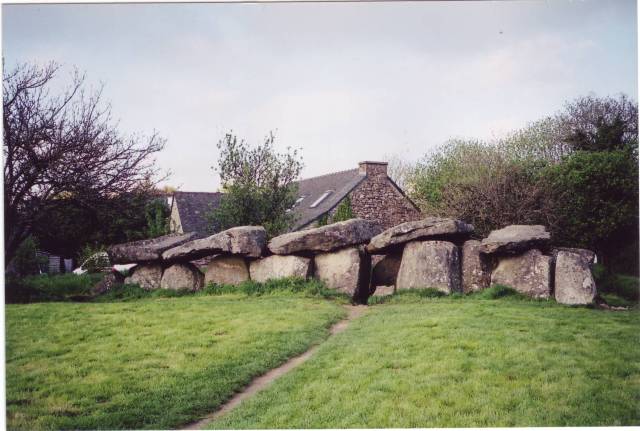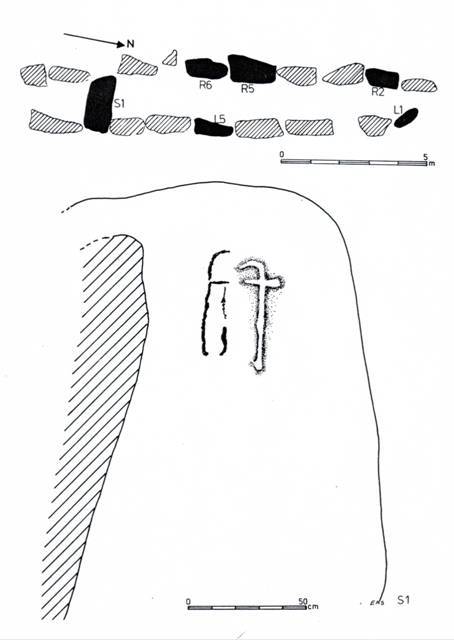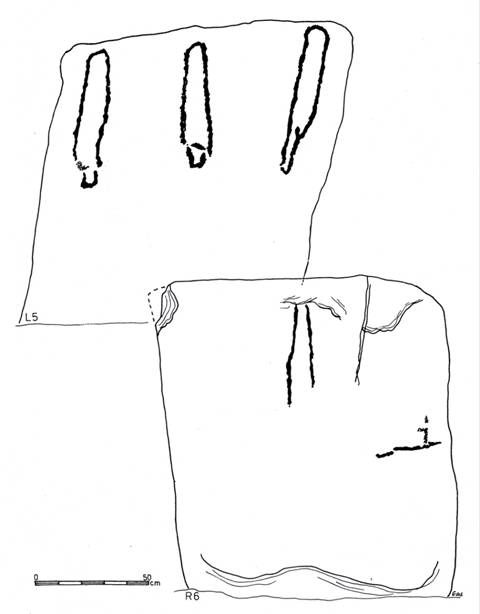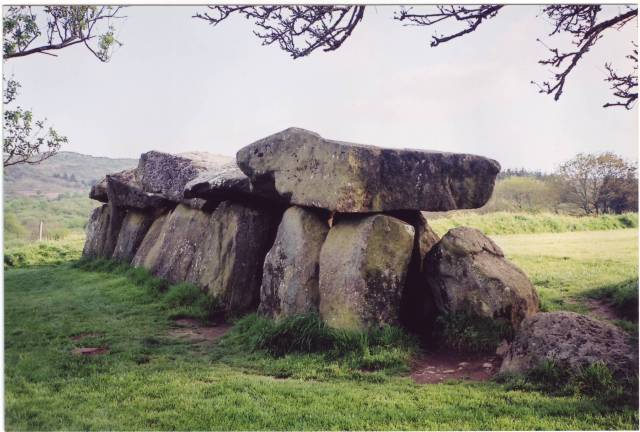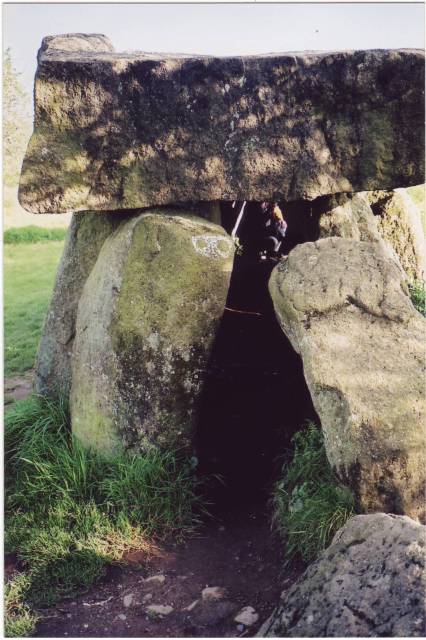
The gallery grave of Mougau-Bihan has the greatest collection of Comet petroglyphs in Brittany. It was built because of the Catastrophe of c.2345 BC. It appears the Disaster was caused by a cosmic collision with a huge Comet. Probably, the Earth was in the tail of this Comet (or Comet Swarm) for a period of two months. After that the whole climate was disrupted for another two months. The calamity is described in the Bible as the Deluge, or the Flood. More than half of the world population perished: 2.6 million men (54%). It happened at the start of the Sixth Dynasty of Egypt (c.2370-2189 BC), which leaded to the end of the Old Kingdom.
The megalithic culture of Western Europe lasted for four millennia, from 5500 to 1500 BC. The passage graves of this time period were a kind of pre-Christian churches of the Sun religion.1-5 Most of them are located along the West Coast of Europe, close to the Atlantic. They point with their important burial chambers to the west. Their petroglyphs have geographic meanings. They show that people wanted to reach the unknown back side of the planet Earth (America). Because of the enormous size of the Ocean this whole episode lasted for a long time, until c.2500 BC.
Brittany, in France, is the most important center of this culture. However, besides the passage graves, suddenly so-called "gallery graves" appear.6-10 These have a fundamentally different architecture compared to the traditional passage graves. The petroglyphs inside are completely different, too. These donít have geographic meanings. The passage graves of Brittany are situated along the coast, but the new gallery graves are spread over the entire peninsula. The question arises why this curious development happened?
In the gallery part about nine more or less similar petroglyphs are engraved. In the literature these are usually described as "daggers" sometimes as "death palettes"6-10 However, these turn out to be images of Comets! On Stone L5 (fig.4, above) are three equally sized petroglyphs of probably the same Comet. Because of the hugh distance, one cannot determine exactly how it looks like. One reaches the conclusion that the tail at the end (below) is transparent. For that reason one renders this part narrowed down. On Stone R6 (fig.4, below) is a similar image. The Comet was disappearing behind the clouds, represented by the natural relief at the upper edge of the stone. So, it is far away . . . .
On stone R5 (fig.5, below) the head of a Comet is indicated at the left side above. However, in reality the head is much smaller, and often difficult to see. One decides to leave it out. In the two central petroglyphs one carves at the bottom a kind of channel in the transparent portion. People thought it contained less material. On the other hand one considers it as a detail. It is important, however, that this lowest part of the Comet is thin and transparent. For that reason one renders this lowest part narrowed down, again. Finally, one agrees on the petroglyph at the right side. This one is executed in a beautiful way. It becomes the "image-convention" Sometimes, however, a Comet has a curved tail. This was fixed down on Stone L1 (fig.5, left above).
Most Comets or "tail stars" are dirty ice balls having diameters of 0.1 to 20km. They move in huge, oblong orbits around the Sun. However, in exceptional cases they can be much bigger. It that case they are really dangerous! When approaching the Sun, a part of the material evaporates, and a long, luminescent tail develops, which might be visible from the Earth. However, in general the amount of evaporated material is scanty, and the end of the tail has a thin and transparent character. Sometimes, the head or coma can be discriminated, and sometimes the tail is deflected. Usually, a Comet can only be observed with the naked eye for a few months.
Images of Comets also occur in Kerguntuil and Prajou Menhir, two closely situated monuments at the north coast of Brittany.6-10 These new astronomic petroglyphs have nothing to do with scientific curiosity. They indicate a big Catastrophe happened with very serious consequences! B.J. Peiser collected a whole bibliography about this subject.11-16 It appears that a cosmic collision occurred with the "Tail" of a Comet, because in all these petroglyphs the head of the Comet was not carved separately. The petroglyph of the Kermorvan menhir, due west of this grave, supports this conclusion, because it strongly suggests a path of the planet Earth through the tail of a huge Comet, or Comet Swarm.24
In the traditional passage graves, a narrow passage leads to a wider burial chamber in the usual way. The passage represents the "Land of the Living" and the burial chamber symbolizes the "Realm of the Dead" a kind of Paradise.1-3 Immediately after the big Catastrophe of c.2345 BC,11-20 many gallery graves were built. Mougau-Bihan is a good example. The groundplan in fig.3 shows that the entrance to "Paradise" was blocked by the Big Stone S1. It appears that a lot of people were not able to reach Paradise. So, the architecture of the grave shows a great Disaster (dis= evel, aster= star) happened. Note, that the whole gallery grave has the shape of a Comet (fig.3). So, these have to be called "Comet Graves" They have a short "head part" and a long "tail part".
Stone R2 near the entrance bears the most beautiful image of a Comet (fig.5, right above). It may represent the Comet that caused the Big Catastrophe. Its top points to a large semi-circular carving at the upper edge. It represents the planet Earth, which was involved in a cosmic collision. The Comet points to the edge of the Earth, so it was not a head-on collision. Two pairs of bosses in haut-relief are shown nearby, a big one and a smaller one.
In the literature such bosses are interpreted as "breasts" in a culture supposedly based on a Mother-goddess.6,7 However, this suggestion is wrong. It appears these are astronomic petrogyphs. Each boss represents the full Moon, but also the time period between two full Moons, which is the so-called Synodical Month, lasting 29.5 days. So, a pair of bosses is a Double-Month, lasting 2x29.5= 59 days. Note, that both carvings suggest there were "two different time periods of equal length" during the Catastrophe. Note also, that the Comet glyph on Stone R2 consists of a wide part and a narrow part, again, of about equal length.
The bigger Double-Moon carving suggests, that the Earth passed through the tail of the Comet during a time period of two months. It resulted in huge forest fires because of falling rocks, and in tremendous floodings because of torrential rains. There is a vast amount of literature about these fires and flooding.11-21 This time period was the worst. The carving is repeated on the entrance Stone L1 (fig.1). The two Stones L1 and L2 on the groundplan appear to confirm these first two months (figs.3).
The smaller carving on Stone R2 (fig.5) suggests the Earth tried to recover during another period of two months, because the whole climate was disrupted. During this period huge floodings continued, because of the steady, heavy downpour.11-15 So, in total the Catastrophe lasted for four months. The four huge coverstones on the passage (the tail part of the Comet Grave) appear to confirm it. Other megalithic sites in Brittany, such as Kermorvan, Tresse and Prajou Menhir, confirm this story.22
M. Baillie shows in a review article13, that the Flood of the Bible was caused by the same event. According to the holy book of the Christians the Flood lasted five months or "150 days" which is approximately correct.21 There are many signs of a much colder climate after the Catastrophe, which lasted for centuries.11-21 The Comet Grave of Mougau-Bihan points with its end-chamber almost due south (fig.3), probably referring to the warmer time period before the Catastrophe.
On Blocking Stone S1 a Mediterranean sign is carved in haut relief (fig.3, below). It is a traditional geographic petroglyph, which would not be expected here. Such signs also occur in Dissignac, St. Nazaire, and on the Stele of Mane-er-Hroek, at Carnac.1-3,7 The long handle below represents the Mediterranean Sea, the left side branch is the sailing route from the Strait of Gibraltar to the south, and the right side branch is the sailing route from Gibraltar to the north (Brittany). It is the holy symbol of the Great People around the Mediterranean. However, here, the upper line curves via the Azores, in the middle of the Ocean, in the direction of the Southern Atlantic. It appears to be a bad message! It means that a lot of people drowned in an "Ocean of Water" It confirms a Catastrophe happened.
At the left side of the sign the groundplan of the Comet Grave was carved in bas relief (see fig.3, below). Below in the glyph the "tail part" is shown, and on top is the open end-chamber. The upper line of the Mediterranean sign points to this isolated end-chamber, which symbolizes Death! Again, it is confirmed that a lot of people perished during this Catastrophe.- Inscriptions in haut relief, like the Mediterranean sign, only occur after the discovery of America, c.2500 BC.1-3 This is correct, because the Catastrophe occurred 150 years later, c.2350 BC.
The stone rows at both sides of the tail part each consist of seven upright stones (fig.3). Mougau-Bihan has a total of five huge coverstones (fig.1), suggesting a world population before the Catastrophe of about 5 million men (a number of seven figures). Before the eastern entrance are two upright stones at that side, suggesting 2 million casualties. The end-chamber, symbolizing Death, has two western stones, confirming it. The most important petroglyph is on western Stone R2 (fig.5), confirming it, again. After the eastern entrance are a total of six stones at that side, which encode an additional six hundred thousand casualties (a number of six figures). Before the western exit are six stones, confirming it. So, together, there were 2.6 million casualties.
The Comet Grave of Mougau-Bihan is located at 48oN. This latitude corrects the world population before the Catastrophe to 4.8 million men. The relative latitude on the northern hemisphere confirms the total number of casualties: (48/90)x4.8= 2.6 million men. This is 54% of the world population. The Mediterranean sign on the Blocking Stone S1 shows the geographic situation around the Strait of Gibraltar, at 36oN (fig.3). This latitude refers to the circumference of the planet Earth of 360o, which strongly confirms that it was a Worldwide Catastrophe (which also occurred in America). The complementary latitude of 90o-36o= 54oN confirms the percentage of the world population that died: 54%. The number of people that survived can be calculated: 4.8-2.6= 2.2 million men. A lot of them were seriously wounded.
Two carbon-datings are known from the Comet Grave of Liscuis II in Laniscat, in the center of Brittany, 2500 BC and 2220 BC. The nearby grave of Liscuis III provided a similar value of 2250 BC.6 These datings are accurate enough to draw the conclusion, that the important Comet Graves of Brittany were built just after the Big Catastrophe of 2345+/-5 BC. This accurate date was determined by M. Baillie with the aid of dendrochronology, so with tree-ring dating.13,20 These tree-rings turn out to be very sensitive to climate changes. The mentioned year has been confirmed by five researchers of different disciplines in a variety of ways.11,14
The groundplan of Mougau-Bihan is shown in fig.3. The east side of the grave (below) faces Egypt. After the lateral entrance in the "tail part" is a series of five stones (L3-L7), which appear to encode the Fifth Dynasty of Egypt. Big menhir S1 clearly blocks the continuation of this series. So, the Comet Catastrophe has put an end to the Fifth Dynasty. After Stone S1 there is still another stone (L8) in the "head part". This section symbolizes Death. So, it appears the Catastrophe happened at the start of the Sixth Dynasty (c.2370-2189 BC). It is in agreement with the date of Baillie of 2345 BC.13
The west side of the Comet Grave (Figs.2 and 3, above) faces the Realm of the Dead (or Central America).1-3 Counted from the entry, there is a series of five stones (R1-R5), again, finishing with big Stone R5 having petroglyphs. So, it is confirmed that the "Disaster" ended the important Fifth Dynasty. However, the series has a total of six stones (add R6), which confirms the calamity happened in the Sixth Dynasty, the last one of the Old Kingdom.
Note, that the tail part of Mougau-Bihan has five upright stones bearing petroglyphs (fig.3, the dark stones), which symbolize the first five Dynasties of the Old Kingdom. The sixth upright stone with petroglyphs is Blocking Stone S1, representing the Sixth Dynasty when the Catastrophe occurred. It would be the last one of the Old Kingdom. In the Catastrophe Literature of Peiser11-16 it is shown, that all other ancient civilizations on Earth, like those of Mesopotamia, India, and China, were terminated as well.
There is an urgent need to decipher the encodings of the Megalith Builders, so we can learn more about the past, but also about the dangers of Comets and other celestial objects in the future, which might threaten us from the sky. Author W.M. Napier has warned us for the consequences if no proper action is taken in this field.17,18
1. Jonge, R.M. de, and Wakefield, J.S, How the Sungod Reached America, A
Guide to Megalithic Sites, MCS Inc., 2002 (ISBN 0-917054-19-9). Available: MCS
Inc., Box 3392, Kirkland, Wa 98083-3392, also on CD
2. Website: www.howthesungod.com, De Jonge, R.M., and Wakefield, J.S.
3. Jonge, R.M. de, and IJzereef, G.F., De Stenen Spreken, Kosmos Z&K,
Utrecht/Antwerpen,1996 (ISBN 90-215-2846-0) (Dutch)
4. Jonge, R.M. de, and Wakefield J.S., The Discovery of the Atlantic Islands,
Migration & Diffusion, Vol.3, No.11, pgs.69-109 (2002)
5. Jonge, R.M. de, and Wakefield J.S., A Nautical Center for Crossing the
Ocean, Americaís Stonehenge, New Hampshire, c.2200 BC, Migration & Diffusion,
Vol.4, No.15, pgs.60-100 (2002)
6. Twohig, E. Shee, The Megalithic Art of Western Europe, Clarendon Press,
Oxford, 1981
7. Briard, J., The Megaliths of Brittany, Gisserot, 1991
8. Balfour, M., Megalithic Mysteries - An Illustrated Guide to Europeís
Ancient Sites, Collins & Brown, 1992 (ISBN 1-85585-3558)
9. Giot, P.R., Prehistory in Brittany, Ed JOS (ISBN 2-85543-123-9)
10. Giot, P.R., Aimer la Bretagne, des Megalithes, Ed. Ouest France, 1995
(ISBN 2-7373-1388-0) (French)
11. Peiser, B.J., Palmer, T., Bailey, M.E., Natural Catastrophes during Bronze
Age Civilizations, BAR International Series 728, Oxford, 1998 (ISBN 0-86054-916-
X)
12. Bruce Masse, W., Earth, Air, Fire, and Water, The Archaeology of Bronze
Age Cosmic Catastrophes, Ref.11, pgs.53-92
13. Baillie, M.G.L., Hints that Cometary Debris played some Role in several
Tree-Ring Dated Environmental Downturns in the Bronze Age, Ref.11, pgs.109-117.
14. Peiser, B.J., Evidence for a Global Disaster in the Late 3rd Millennium BC,
Ref.11, pgs.117-140.
15. Courty, M.-A., The Soil Record of an Exceptional Event at 4000 BP in the
Middle East, Ref.11, pgs.93-109.
16. Pankenier, D.W., Heaven-Sent: Understanding Cosmic Disaster in Chinese Myth
and History, Ref.11, pgs.187-197
17. Clube, S.V.M., and Napier, W.M., The Cosmic Serpent, Faber and Faber,
London, 1982
18. Clube, S.V.M., and Napier, W.M., The Cosmic Winter, Blackwell, Oxford, 1990
19. Joseph, F., Survivors of Atlantis, Their Impact on World Culture, Bear &
Co., Vermont 2004 (ISBN 1-59143-0-040-2)
20. Baillie, M.G.L., Exodus to Arthur, Catastrophic Encounters with Comets, BT
Batsford Ltd., London, 1999 (ISBN 0-7134-8681-3)
21. Palmer, T., Catastrophes, the Deluvial Evidence, Website
22. Jonge, R.M. de, and Wakefield, J.S, Personal communication, to be
published.
23. Cope, J., The Megalithic European, Harper Collins, 2004
24. Jonge, R.M. de, "The Comet Catastrophe of c.2345 BC, (The Kermorvan menhir
and the Tresse grave, Brittany)" to be published.

